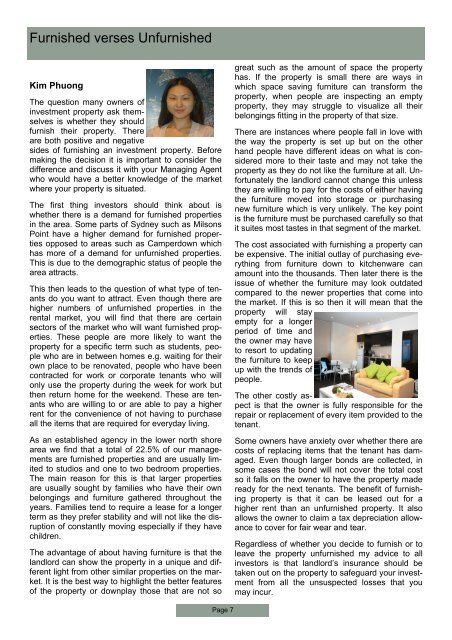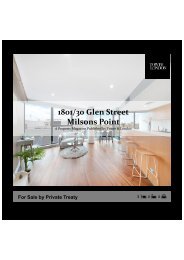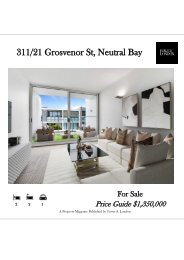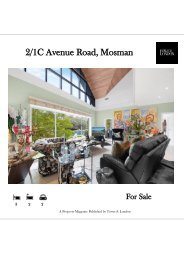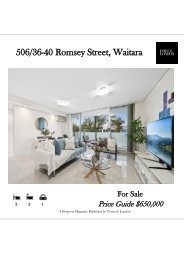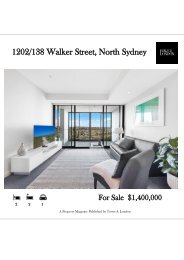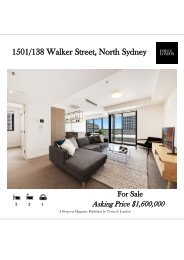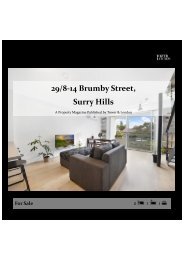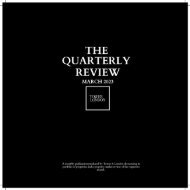Create successful ePaper yourself
Turn your PDF publications into a flip-book with our unique Google optimized e-Paper software.
Furnished verses Unfurnished<br />
Kim Phuong<br />
The question many owners of<br />
investment property ask themselves<br />
is whether they should<br />
furnish their property. There<br />
are both positive and negative<br />
sides of furnishing an investment property. Before<br />
making the decision it is important to consider the<br />
difference and discuss it with your Managing Agent<br />
who would have a better knowledge of the market<br />
where your property is situated.<br />
The first thing investors should think about is<br />
whether there is a demand for furnished properties<br />
in the area. Some parts of Sydney such as Milsons<br />
Point have a higher demand for furnished properties<br />
opposed to areas such as Camperdown which<br />
has more of a demand for unfurnished properties.<br />
This is due to the demographic status of people the<br />
area attracts.<br />
This then leads to the question of what type of tenants<br />
do you want to attract. Even though there are<br />
higher numbers of unfurnished properties in the<br />
rental market, you will find that there are certain<br />
sectors of the market who will want furnished properties.<br />
These people are more likely to want the<br />
property for a specific term such as students, people<br />
who are in between homes e.g. waiting for their<br />
own place to be renovated, people who have been<br />
contracted for work or corporate tenants who will<br />
only use the property during the week for work but<br />
then return home for the weekend. These are tenants<br />
who are willing to or are able to pay a higher<br />
rent for the convenience of not having to purchase<br />
all the items that are required for everyday living.<br />
As an established agency in the lower north shore<br />
area we find that a total of 22.5% of our managements<br />
are furnished properties and are usually limited<br />
to studios and one to two bedroom properties.<br />
The main reason for this is that larger properties<br />
are usually sought by families who have their own<br />
belongings and furniture gathered throughout the<br />
years. Families tend to require a lease for a longer<br />
term as they prefer stability and will not like the disruption<br />
of constantly moving especially if they have<br />
children.<br />
The advantage of about having furniture is that the<br />
landlord can show the property in a unique and different<br />
light from other similar properties on the market.<br />
It is the best way to highlight the better features<br />
of the property or downplay those that are not so<br />
great such as the amount of space the property<br />
has. If the property is small there are ways in<br />
which space saving furniture can transform the<br />
property, when people are inspecting an empty<br />
property, they may struggle to visualize all their<br />
belongings fitting in the property of that size.<br />
There are instances where people fall in love with<br />
the way the property is set up but on the other<br />
hand people have different ideas on what is considered<br />
more to their taste and may not take the<br />
property as they do not like the furniture at all. Unfortunately<br />
the landlord cannot change this unless<br />
they are willing to pay for the costs of either having<br />
the furniture moved into storage or purchasing<br />
new furniture which is very unlikely. The key point<br />
is the furniture must be purchased carefully so that<br />
it suites most tastes in that segment of the market.<br />
The cost associated with furnishing a property can<br />
be expensive. The initial outlay of purchasing everything<br />
from furniture down to kitchenware can<br />
amount into the thousands. Then later there is the<br />
issue of whether the furniture may look outdated<br />
compared to the newer properties that come into<br />
the market. If this is so then it will mean that the<br />
property will stay<br />
empty for a longer<br />
period of time and<br />
the owner may have<br />
to resort to updating<br />
the furniture to keep<br />
up with the trends of<br />
people.<br />
The other costly aspect<br />
is that the owner is fully responsible for the<br />
repair or replacement of every item provided to the<br />
tenant.<br />
Some owners have anxiety over whether there are<br />
costs of replacing items that the tenant has damaged.<br />
Even though larger bonds are collected, in<br />
some cases the bond will not cover the total cost<br />
so it falls on the owner to have the property made<br />
ready for the next tenants. The benefit of furnishing<br />
property is that it can be leased out for a<br />
higher rent than an unfurnished property. It also<br />
allows the owner to claim a tax depreciation allowance<br />
to cover for fair wear and tear.<br />
Regardless of whether you decide to furnish or to<br />
leave the property unfurnished my advice to all<br />
investors is that landlord’s insurance should be<br />
taken out on the property to safeguard your investment<br />
from all the unsuspected losses that you<br />
may incur.<br />
Page 7


